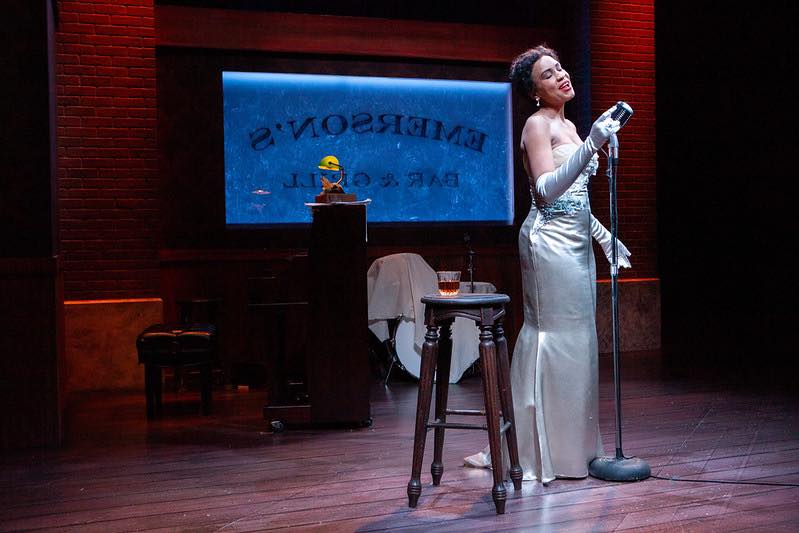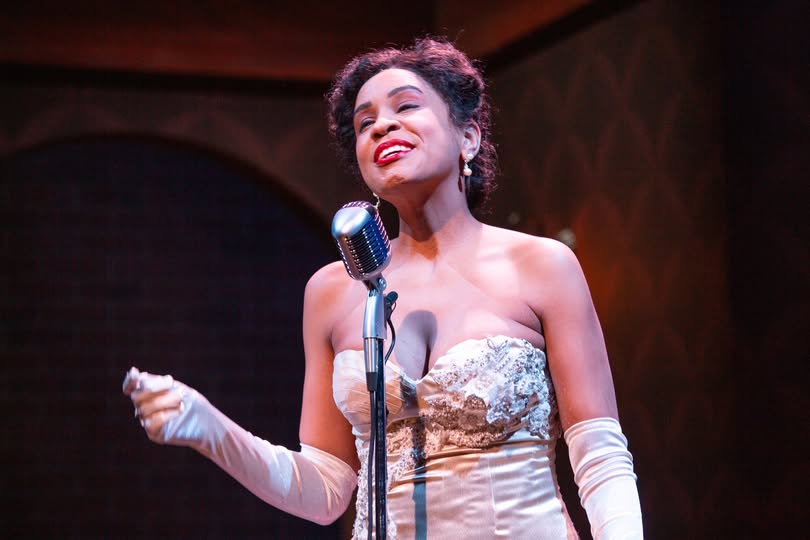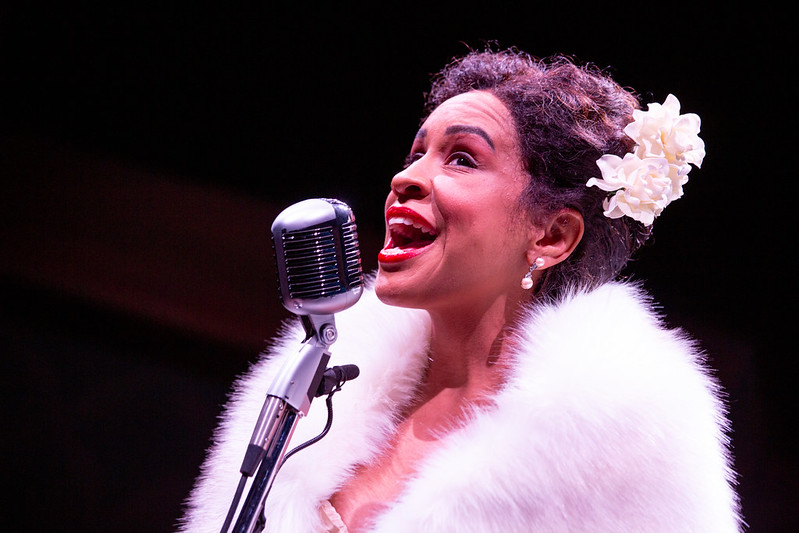
‘Lady Day At Emerson’s Bar and Grill’ by Lanie Robertson. Directed by Candice Handy. Music Direction by David Freeman Coleman. Scenic Design by Tony Hardin. Costume Design by Yao Chen. Lighting Design by Brian Lillienthal. Sound Design by David Remedios. At Merrimack Repertory Theatre, Lowell, Massachusetts, through February 23, 2025.
By Linda Chin
Merrimack Repertory Theatre’s mesmerizing revival of Lady Day (last produced in 1998 and “one of MRT audiences’ favorite plays of all time”) transports us back to 1959 to the fictional club in South Philly, where jazz legend Billie Holiday gave one of her last concerts about four months before her passing at 44 years young. Lady Day at Emerson’s Bar and Grill serves up slices of American music history peppered with pieces of Holiday’s personal history and blends in some lesser-known facts (e.g. the origin of the nickname “Lady Day” is attributed to prominent saxophonist Lester Young from Count Basie’s Orchestra). Audience members, young or old, and familiar with her music and life story (or not) will find this production (ninety minutes without intermission) entertaining, educational, and engaging.
Lady Day is a carefully crafted two-hander with Billie Holiday and her accompanist Jimmy Powers carrying the day. In her portrayal of the titular character, Jenece Upton delivers a pitch-perfect performance. Her voice and physical presence – singing with her head tilted back at just the right angle – and interpreting the songs with her entire being were spot-on. Upton’s delivery of the numerous off-the-cuff monologues and random musings were beautifully paced and eloquently articulated – akin to an acting master class.
Playwright Lanie Robertson sensitively interweaves Holiday singing iconic tracks (including “What a Little Moonlight Can Do,” “T’ain’t Nobody’s Business If I Do,” “God Bless the Child” and “Strange Fruit”) with her sharing anecdotes about her childhood, teenage years, and life as a colored woman and artist of color in a society where racism is rampant.

At the concert that is depicted this evening, we do not witness Billie at the peak of her career. She has made it to the club but calls from off-stage that she is not up to performing, leaving Jimmy to fill in. When she does appear, her emotional and physical deterioration is evident. More of Lady Day is devoted to the lows in Holiday’s life (battles with alcoholism and drug abuse, being raped at age 10, being raised in poverty, her troubled marriage, getting arrested and serving a prison sentence for narcotics possession, not being able to get a cabaret license) than the highs. I wish there was more opportunity to celebrate her accomplishments (she was the first African-American woman to work with an all-white orchestra (led by Artie Shaw), performed with greats Count Basie and Benny Goodman, had repeat curtain calls at sold-out performances at Carnegie Hall, and had a stellar recording career) than admire her for her perseverance and resilience.
Moments when Holiday’s natural musical genius, high EQ (emotional quotient), and resilience are authentically and effortlessly revealed, when she was unapologetically herself, were the play’s highlights. I was particularly moved when she expressed that one of her biggest sadnesses was that she didn’t have children of her own (getting raped as a ten-year-old or getting addicted to heroin and being framed by her husband were not the worst parts of her life). Despite tremendous personal obstacles, Holiday was not a victim but a survivor.
I also greatly appreciated her approach to performing, which seemed to come naturally to her. “I don’t think I ever sing the same way twice. Anything I do sing is part of my life.” “If I’m going to sing like someone else, then I don’t need to sing at all.” “I hate straight singing. I have to change a tune to my own way of doing it. That’s all I know.” Holiday understood the healing power of music, creative expression, and innovation. She also understood creative collaboration, acknowledging her accompanist, Jimmy, for his talent and kind, calm demeanor. Actor-musician Michael Matlock did a magnificent job filling in as Jimmy Powers for previews and opening weekend, including the performance I saw. In both musical accompaniment and scene partnering with Upton, their strong harmony and chemistry were palpable.

In Lady Day, Billie expressed her negative feelings about Philadelphia: “I used to tell everybody. When I die, I don’t care if I go to heaven or hell, long’s it ain’t in Philly.” I didn’t know it at the time, but readers may be glad to know that she got her wish (she died at a hospital and was buried in NYC). Also, Lady Day holds a special place in local history; the last two performances Billie gave before she passed away in 1959 were at the Storyville Club in Boston and The Flamingo Lounge in Lowell. Audiences can experience an intimate cabaret experience in Lowell at MRT through February 23rd. For tickets and information, go to: https://mrt.org/

